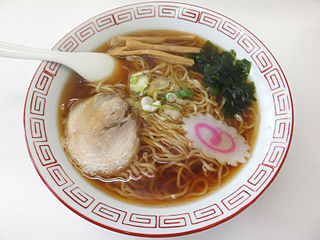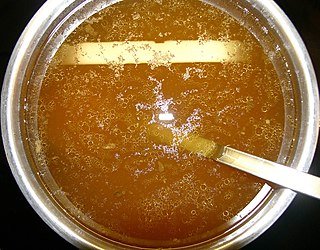
Ramen is a Japanese noodle dish. It consists of Chinese-style wheat noodles served in a broth; common flavors are soy sauce and miso, with typical toppings including sliced pork, nori, menma, and scallions. Ramen has its roots in Chinese noodle dishes. Nearly every region in Japan has its own variation of ramen, such as the tonkotsu ramen of Kyushu and the miso ramen of Hokkaido.

Chicken soup is a soup made from chicken, simmered in water, usually with various other ingredients. The classic chicken soup consists of a clear chicken broth, often with pieces of chicken or vegetables; common additions are pasta, noodles, dumplings, or grains such as rice and barley. Chicken soup has acquired the reputation of a folk remedy for colds and influenza, and in many countries is considered a comfort food.

Broth, also known as bouillon, is a savory liquid made of water in which meat, fish or vegetables have been simmered for a short period of time. It can be eaten alone, but it is most commonly used to prepare other dishes, such as soups, gravies, and sauces.

Stock, sometimes called bone broth, is a savory cooking liquid that forms the basis of many dishes – particularly soups, stews, and sauces. Making stock involves simmering animal bones, meat, seafood, or vegetables in water or wine, often for an extended period. Mirepoix or other aromatics may be added for more flavor.

Pares, also known as beef pares, is a term for a serving of Filipino braised beef stew with garlic fried rice, and a bowl of clear soup. It is a popular food particularly associated with specialty roadside diner-style establishments known as Pares Houses that specialize in serving these type of meals. In recent years, it had also become a common dish served in small eateries called karinderya or carinderia that serve economical meals for local residents.

Bouillabaisse is a traditional Provençal fish soup originating in the port city of Marseille. The French and English form bouillabaisse comes from the Provençal Occitan word bolhabaissa, a compound that consists of the two verbs bolhir and abaissar.

Naengmyeon or raengmyŏn is a noodle dish of North Korean origin which consists of long and thin handmade noodles made from the flour and starch of various ingredients, including buckwheat, potatoes, sweet potatoes, arrowroot starch, and kudzu. Buckwheat predominates. Other varieties of naengmyeon are made from ingredients such as seaweed and green tea.

Noodle soup refers to a variety of soups with noodles and other ingredients served in a light broth. Noodle soup is a common dish across East Asia, Southeast Asia and the Himalayan states of South Asia. Various types of noodles are used, such as rice noodles, wheat noodles and egg noodles.

Soups in East Asian culture are eaten as one of the main dishes in a meal or in some cases served straight with little adornment, particular attention is paid to the soups' stocks. In the case of some soups, the stock ingredients become part of the soup. They are usually based solely on broths and lacking in dairy products such as milk or cream. If thickened, the thickening usually consists of refined starches from corn or sweet potatoes.

Batchoy, alternatively spelled batsoy, is a Filipino noodle soup of pork offal, crushed pork cracklings, chicken stock, beef loin, and round noodles. The original and most popular variant, the La Paz batchoy, traces its roots to the Iloilo City district of La Paz, in the Philippines.

Jjamppong is a Chinese-style Korean noodle soup with red, spicy seafood- or pork-based broth flavored with gochugaru. Common ingredients include onions, garlic, Korean zucchini, carrots, cabbages, squid, mussels, and pork. The dish was inspired by Chinese cuisine.

The Philopteridae are a family of Ischnocera, chewing lice mostly parasitic on birds.

Kal-guksu is a Korean noodle dish consisting of handmade, knife-cut wheat flour noodles served in a large bowl with broth and other ingredients. It is traditionally considered a seasonal food, consumed most often in summer. Its name comes from the fact that the noodles are not extruded or spun, but cut.

Korean noodles are noodles or noodle dishes in Korean cuisine, and are collectively referred to as "guksu" in native Korean or "myeon" in hanja character. Preparations with noodles are relatively simple and dates back to around BC 6000 to BC 5000 in Asia. In Korea, traditional noodle dishes are onmyeon, called guksu jangguk, naengmyeon, bibim guksu, kalguksu, kongguksu among others. In royal court, baekmyeon consisting of buckwheat noodles and pheasant broth, was regarded as the top quality noodle dish. Naengmyeon, with a cold soup mixed with dongchimi and beef brisk broth, was eaten in court during summer.

Chicken and dumplings is a soup that consists of a chicken cooked in water, with the resulting chicken broth being used to cook the dumplings by boiling. A dumpling—in this context—is a biscuit dough, which is a mixture of flour, shortening, and liquid. The dumplings are either rolled out flat, dropped, or formed into a ball.

Mie celor, is a Southeast Asian noodle soup dish served in a coconut milk and shrimp-based broth, specialty of Palembang city, South Sumatra, Indonesia.

Soto mie, Soto mi, or Mee soto is a spicy Indonesian noodle soup dish commonly found in Indonesia, Malaysia, and Singapore. Mie means noodle made of flour, salt and egg, while soto refers to Indonesian soup. In Indonesia, it is called soto mie and is considered one variant of soto, while in Malaysia and Singapore it is called mee soto.

Hot pot or hotpot, also known as soup-food or steamboat, is a dish whereby a heat source placed on the dining table keeps a pot of soup stock simmering, and a variety of Chinese foodstuffs and ingredients are served beside the pot for the diners to put into the hot stock.

Ditrichaceae is a family of haplolepideous mosses (Dicranidae) in the order Dicranales.


















